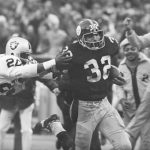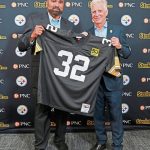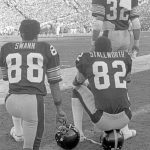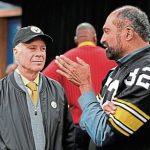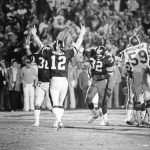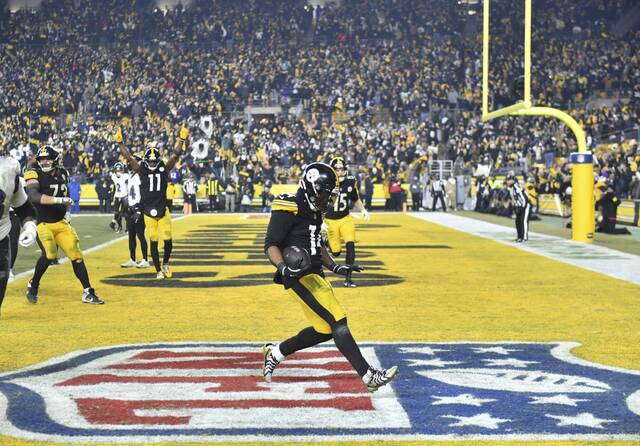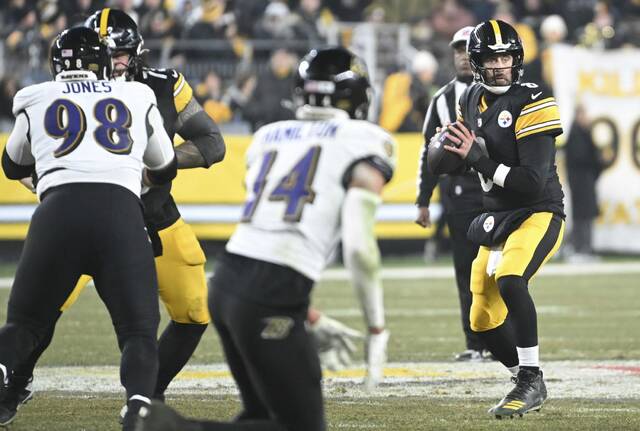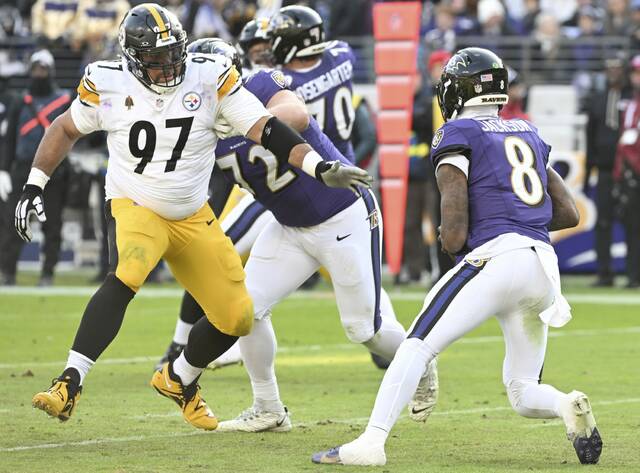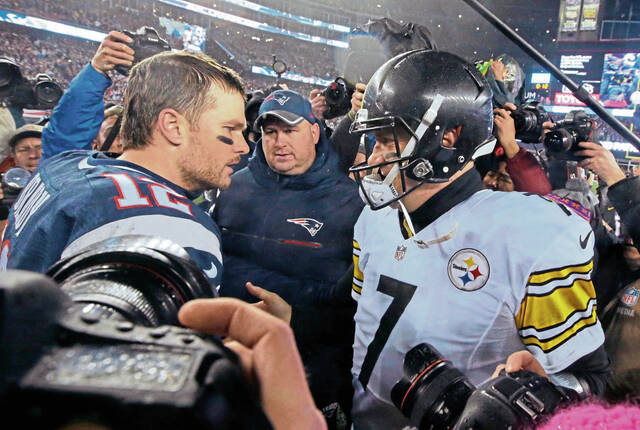Editor’s note: This story originally published on Dec. 18, 2022, three days before the death of Franco Harris.
Franco Harris remembers what he said to himself going into the huddle moments before the defining play of his Pro Football Hall of Fame career.
“The thoughts that come into your mind during a game can have an effect on the game, and going into the huddle I remember telling myself ‘Franco, this will probably be the last play of the season,’ ” Harris said. “ ‘Play it to the end.’ ”
For Harris the play continues to reinforce a valuable lesson.
“You learn from this play,” he said, “you never give up.”
Running back John “Frenchy” Fuqua was Terry Bradshaw’s intended receiver for 66 Halfback Circle Option. The play ended up working spectacularly well but not the way it had been drawn up.
In a way no one could have predicted, it resulted in The Immaculate Reception by Harris, voted the “Greatest Play in NFL History” for the league’s 100th anniversary in 2019. It gave the Steelers a miraculous victory — the first postseason win in franchise history — and a half-century later, Pittsburgh is still celebrating it.
‘Beyond my wildest expectations’
Until Dec. 23, 1972, the Steelers were one of the most underwhelming franchises in NFL history. They only had seven winning seasons in their first four decades and had made the playoffs just once, in 1947, not counting the 1962 Playoff Bowl loss to the Detroit Lions (a meaningless consolation game for third place in the league). The Steelers lost to the Philadelphia Eagles, 21-0, in that 1947 playoff game.
The Immaculate Reception changed the future of a franchise and the identity of the city it calls home. It also was 47th on Sports Illustrated’s list of the 100 Greatest Moments in Sports History.
The 1970s were a tough decade for Pittsburgh, which saw its steel industry and population slip into the early stages of a steep decline.
Before 1972, the Steelers hadn’t given Pittsburgh much to be proud of. That season, however, is when things began to turn around. The Steelers put together an 11-3 record and won their first AFC Central Division title. Harris, fresh out of Penn State, rushed for 1,055 yards, scored 11 touchdowns and was named the NFL’s Offensive Rookie of the Year. A fan club, Franco’s Italian Army, emerged and inducted Frank Sinatra into its membership.
“I had a great start in 1972, and the season went beyond my wildest expectations and I would say beyond anyone in the front office or any coach’s expectations that year,” Harris said.
There was enormous excitement for the playoff game at Three Rivers Stadium. The Steelers were set to take on the AFC West Division champion Oakland Raiders in the first postseason game of what became a bitter and bruising rivalry.
Tickets were hard to come by, and the game was not shown on live television in Pittsburgh because, per NFL rules at the time, home games were blacked out even though there was a sold-out crowd of 50,327 at Three Rivers Stadium. The league soon changed that rule, but if you lived in Pittsburgh and didn’t have a ticket, your only option was to listen to the game on the radio or drive 75 miles outside the Pittsburgh market to a town where the game was broadcast.
Strange sequence of events
The game was a physical, defensive battle that was scoreless at halftime. The Steelers scored the first points in the third quarter on an 18-yard Roy Gerela field goal. Gerela kicked a 29-yarder in the fourth quarter to stretch the lead to 6-0. With the Steelers playing shutdown defense, it looked as though that would be the only points they would need.
However, the Raiders drove to the Steelers’ 30-yard line late in the game. With 1:17 left to play, Raiders quarterback Ken Stabler outsmarted the Steelers’ blitzing defenders and ran for a go-ahead touchdown. The Raiders led 7-6, and even though the Steelers would get the ball back one more time, things weren’t looking good.
“We had a blitz on, and the one thing about a blitz, you cannot let the quarterback get outside the pocket,” said Jack Ham, a legendary Steelers linebacker who went on to be inducted into the Pro Football Hall of Fame. “You’ve got to make sure you contain him. We didn’t do it on the play, and Kenny Stabler saw an opening on that side and ended up running for the touchdown. You held them for almost the entire football game, and to give up a play like that at the end of the game was very deflating.”
Related:
• How 2 Steelers fans nabbed the Immaculate Reception ball — and still have it todayThough Ham avoided singling anyone out, it was defensive tackle Craig Hanneman who lost containment on Stabler. Hanneman’s Steelers roommate, offensive lineman Jon Kolb, managed to put a positive spin on the play.
“We were good friends. I was the best man in his wedding, but if Craig doesn’t lose containment, then we win the game (at that point) because Oakland doesn’t score and they don’t go ahead on us. (The Steelers offense) goes back out on the field and just falls on the ball three times (to run out the clock) and the game is over,” Kolb said.
“If that doesn’t happen, then (The Immaculate Reception) doesn’t happen. A series of events needed to happen. Franco owes a lot to Craig Hanneman. I kid him, ‘You’ve got this statue and they practically name the town after you, and poor Craig Hanneman is the goat of the whole thing.’ ”
‘Somebody forgot to pray to win’
The Steelers had one more possession, but the drive stalled at their own 40-yard line with 22 seconds remaining and no timeouts.
“I didn’t have much hope,” Ham said. “There was some time left on the clock, but we needed to somehow get a first down and go from there. It was kind of depressing, to tell you the truth. I didn’t even see the play. I was cutting tape off (my shoes).
Meanwhile, Steelers coach Chuck Noll was telling Gerela and his holder, Bobby Walden, to prepare for a last-second field-goal attempt.
“Coach Noll called our last timeout and told the field-goal team, ‘Go down to the far end of the field because we’re going to pass this ball, and if it’s complete, you’ve got to run on the field and try a field goal,’” Gerela said.
Fuqua knew he was likely to be involved in the fourth-down play. In those days, before future Hall of Fame receivers Lynn Swann and John Stallworth joined the Steelers, Fuqua was a frequent target out of the backfield. In the 1972 season, he was the team’s fifth-leading receiver.
“My hope, if I caught the ball, was to get into field-goal position,” Fuqua said. “We had a lot of confidence in (Gerela). It would have been close, and I wouldn’t have bet any money on it.”
Kolb remembered Steelers center Ray Mansfield didn’t seem confident in the huddle. Kolb recalled that prior to the Steelers’ final regular-season game the week before in San Diego, some of the Steelers, including Mansfield, attended a chapel service.
“The speaker starts out, and he asks Ray Mansfield what he prays for before a game, and Ray says, ‘I pray nobody gets hurt and the best team wins; that kind of stuff.’ And the speaker says, ‘That’s what’s really on your mind?’ and Ray says, ‘No, I’m thinking about the game and how I want to win the game,’” Kolb said.
The speaker advised the players to be honest with God and admit what they want most is to win.
“So the next week, we’re in the huddle and we run three plays, and now it’s fourth down and forever. And it looked like all was lost. And Terry (Bradshaw) calls the play and as we broke the huddle Mansfield said in a really discouraged voice, ‘Well, somebody forgot to pray to win.’ ”
The Immaculate call
Most Pittsburghers found out about The Immaculate Reception from Steelers play-by-play announcer Jack Fleming’s live radio description:
“Hang onto your hats! Here come the Steelers out of the huddle. Terry Bradshaw at the controls. Twenty-two seconds remaining, and this crowd is standing. Bradshaw, back and looking again. Bradshaw running out of the pocket, looking for someone to throw to, fires it downfield, and there’s a collision! It’s caught out of the air! The ball is pulled in by Franco Harris!! Harris is going for a touchdown for Pittsburgh! Harris is going! Five seconds left on the clock!! Franco Harris pulled in the football, I don’t even know where he came from!!”
‘Go to the ball’
Bradshaw was fortunate to get rid of the ball after barely avoiding being sacked.
“I was in desperation mode. When I moved out of the pocket, I swung my right arm up high to avoid the sack,” Bradshaw said. “I avoided the sack from my left side, and when I went to scramble out of that and went to my right, there was someone reaching for me, and to avoid his grasp I swing my right arm up in the air. When I threw the ball, all I saw was (Fuqua’s) black jersey.”
Fuqua said he was wide open as he waited at the Raiders’ 35.
“When I go into my turn to turn back towards Bradshaw, I see (Raiders safety Jack) Tatum stop and plant his feet and start coming forward. I said, ‘Damn, Tatum is coming. I’m gonna get hit, but we need the first down.’ I had a flashback from our receivers coach (Lionel Taylor) who said, ‘Get between the ball and the defender no matter what,’” Fuqua said. “I accomplished that.
“What happened next was Bradshaw had to scramble. If he had thrown the ball sooner, it would have been no problem. We would have had a first down. But Bradshaw ducked, scrambled, and in those days if Bradshaw looked at you, when them blue eyes looked at you, he was going to throw the ball to you. I went up a couple more yards and he threw the ball. I could hear (Tatum’s) footsteps ‘boom, boom, boom, boom, boom.’ I could hear his breathing.
“It would have been a hell of a catch if I would have made it. It should have been pass interference. He knocked the hell out of me. The ball bounced back.”
The question was who did the ball touch? Tatum or Fuqua or both at the same time? The answer was key because, based on the NFL rules at the time, if a ball was deflected by one offensive player into the hands of a teammate, the catch had to be disallowed.
Based on the way the ball shot back some 7 yards in the opposite direction, laws of physics indicate it deflected off Tatum’s shoulder pad. Fuqua had been knocked flat.
“The ball bounced back,” Fuqua said. “Franco, who always followed up, was there.”
Another serendipitous aspect of the play, according to Bradshaw, was that Harris was not where he was supposed to be.
“The funny thing is, and I told Franco this the other day, Franco was supposed to block. And if you watch that game from the end zone, he didn’t hit a soul,” Bradshaw said. “He didn’t block a person. He just takes a couple of steps back, and he’s looking at me and I’m fighting for my life.”
Harris said he remembered something that his former Penn State coach, Joe Paterno, had told him.
“Terry starts to scramble, and I tell myself, ‘There may be an outlet pass. You can get the first down,’” Harris said. “How lucky were we that Bradshaw’s a big, strong guy that can hold off these tacklers and then throw the heck out of that ball with that velocity? And so when he throws the ball downfield, in my mind comes what Joe Paterno always told us — ‘Go to the ball.’ So when Bradshaw throws the ball, automatically it goes to my mind — ‘Go to the ball.’ That’s what Joe Paterno drilled in us. So I started taking steps to the ball. I remember nothing after that.”
The play everyone remembers is one that Harris can’t fully recall.
“My mind is a complete blank, which is strange because as I remember nothing, I see things on film and I’m saying to myself, ‘How could that happen? How could I catch the ball like that? I never caught a ball like that before. How could I catch a ball like that and that low and that trajectory and not break stride?’ When the pass to Frenchy Fuqua was broken up, some Raiders started to clap for just a few seconds and that few seconds was all I needed. It was the difference (between) me getting into the end zone and not getting into the end zone.”
As Harris ran toward the end zone, it looked like Raiders defensive back Jimmy Warren might catch him. Harris said he thought about going out of bounds to stop the clock but changed his mind and gave Warren a stiff arm while just barely staying in bounds.
“I’m saying to myself, ‘Get into the end zone,’” Harris said. “Don’t even attempt a field goal. Sure, we had two field goals already and a third one would win it, but I’m saying, ‘Get into the end zone.’ ”
The 60-yard touchdown gave the Steelers a 12-7 lead.
‘It was just a miracle’
“We saw Franco catch the ball. The ricochet and collision between Frenchy and Jack Tatum was so loud and quick the ball shot back like a rocket. We figured it was incomplete and then here comes Franco and we could see on the sideline that there’s clearly daylight (between) his hands and the ground,” Gerela said. “The thing is that when he caught it with his fingertips, he had to re-grip it and haul it in and at the same time he stumbled and I said, ‘Oh (crap)! Please stand up and make a go for it,’ which he did. He just outran everybody right down the sideline.”
Fuqua said he especially enjoyed watching the expression change on Tatum’s face.
“I’m watching him jump up and down clapping his hands. As he goes up, he has a smile. As he comes down, he has a frown and all of a sudden he turns and starts running,” Fuqua said. “And I’m saying, ‘What the hell has happened?’ And when I look down the field I see Franco getting ready to cross into the end zone. The next thing that happens is Jack Tatum runs up to me and says, ‘Damn it, Fuqua, tell them you touched that ball.’ I was so stunned I almost said ‘Yeah, I touched it.’ ”
After the game, Steelers broadcaster Myron Cope cautioned Fuqua that a lot of reporters were going to be questioning him about the play.
“He said, ‘Did you touch the ball?’ I did not answer. I said, ‘Myron, should I tell them what really happened or should I just say ‘I’ll never tell?’ And Myron Cope says, ‘Tell them you’ll never tell.’ And I have kept that promise since then.”
Fuqua was convinced about what happened, but others, including some Steelers, had no idea.
“The play was not designed to be a deep pass. I hit the ground and when I hit the ground I heard the crowd go crazy,” Bradshaw said. “And when I got up I knew it was a touchdown and I’m thinking to myself, ‘Wow, that must have been some throw you just made. You son of a gun, you’re going to be a hero to millions now.’ But then I’m going, ‘What happened?’ I didn’t really get an answer because the fans were coming on the field. I got to the sidelines and they said Frenchy had a collision with Tatum and Franco caught the deflection and he ran it in. And you’re going ‘come again? What happened? You are kidding me.’ I couldn’t imagine how that happened. It just didn’t make sense. How crazy a play that is. It was just a miracle.”
Chaos ensued. Fans swarmed the field as soon as Harris crossed the goal line, but only one official immediately signaled touchdown while the others huddled to discuss the play.
“We were wondering whether that play was going to hold up,” Ham said. “It took a long time. Everybody’s on the field. My girlfriend, now my wife, was on the field with all kinds of friends, and I just said, ‘This game is not over. I’m not sure it’s going to stand up yet.’ I’m trying to be rational during a very frenzied time.”
As an entire stadium waited and held its collective breath, referee Fred Swearingen asked to be taken to a phone in one of the baseball dugouts. Swearingen called up to the press box and spoke with the NFL’s supervisor of officials Art McNally. They determined the pass was deflected by Tatum and then Swearingen returned to the field to signal touchdown.
It took 15 minutes to clear the field, so Gerela could kick the extra point that made the final score 13-7.
“When Franco scored that touchdown, it was like a flash mob,” Gerela said. “We looked behind us and we saw the fans already over the fence. But the fans were really good about clearing the field. It was a crazy but nice scene because the fans were very cooperative. They had their moment of glory and they expressed themselves. As soon as I kicked the extra point it was like a flash mob again. It was a great joyous moment that we’ll all remember for a lifetime.”
The following week, the Steelers hosted the undefeated Miami Dolphins in the AFC Championship Game but lost 21-17 as the Dolphins went on to win the Super Bowl and make history by finishing off an undefeated season.
“So much had been taken out of our players (by the Raiders) that we were exhausted mentally and physically,” Fuqua said. “At that time Oakland was one of the most physical teams in the NFL.”
Setting the stage for a dynasty
Even though the Steelers came up short of the Super Bowl, the tone had been set for future Super Bowls and the dynasty that followed — four Super Bowl victories over a six-year period in the 1970s.
“That kind of jump-started us in the sense of getting playoff experience early in our careers,” Ham said. “I’m from this area. I grew up in Johnstown and the Steelers were always known as a tough, hard-nosed team that would always lose in the later stages of the fourth quarter, that never could win something. We won a division championship and we got into the playoffs and this was kind of a springboard for us. You felt that we were on the right track and it was going to be a different Steeler team going forward.”
Bradshaw, who had a rough first couple of years in Pittsburgh, felt the same way.
“You just need some positive results to know that what you’re doing is right and I knew this team was headed in the right direction,” he said.
Fifty years after it happened, The Immaculate Reception still hasn’t lost its luster in Pittsburgh. As part of the 50th-anniversary celebration, Harris’ No. 32 will be retired at halftime of the Steelers’ game Saturday night against the Las Vegas Raiders at Acrisure Stadium.
Hardly a day has gone by in the last 50 years that Fuqua hasn’t been asked about the Immaculate Reception, and he enjoys being coy with his role in history.
“Do I know what happened? Yes, I know exactly what happened,” Fuqua said. “Can I back it up? Yes and I can prove it.”
Fuqua said he was offered thousands of dollars during the 1970s to discuss the details of the play but turned down all offers.
“I have decided to keep it immaculate and I will take it to the grave with me.”











